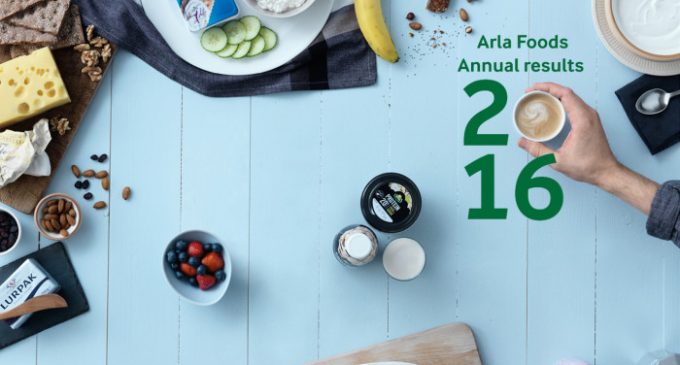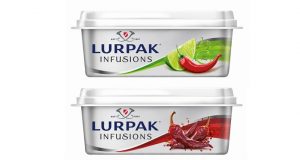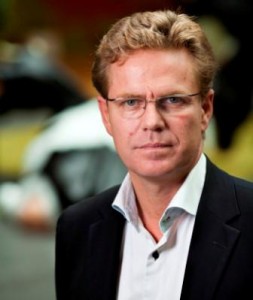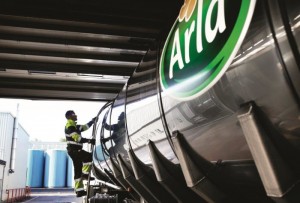Arla Foods Achieves Strong Branded Growth in a Volatile Market

Although group revenue declined by 6.8% to €9.57 billion, as a direct result of lower sales prices in the global dairy market, Arla Foods continued to improve the quality of its sales by moving more milk from bulk to brands, and managed to increase net profit grew by 20.7% to €356 million for its 2016 financial year. Indeed, Arla Foods delivered a solid business performance throughout 2016 and made a strong start to the delivery of its strategy, ‘Good Growth 2020’, despite highly volatile milk markets.
In the second half of the year Arla introduced increases in its prepaid milk price to farmers by nearly 30 per cent and expects annual revenue and performance price to improve in 2017.
In a year with extreme volatility in raw milk production and farm gate prices, Arla delivered financial results above its targets on most measures, with net profit at 3.6% of sales, a strategic branded volume driven revenue growth of 5.2% and a growth in brand share to 44.5%. Leverage was 2.4.
During the first eight months of 2016, the dairy industry was characterised by low global milk prices due to a period with an over-supply of milk, particularly in Europe. European milk supply then declined significantly in the second half of the year, supporting a significant milk price rally.
In the last four months of 2016 Arla delivered four consecutive increases in the on-account milk price – representing close to a 30% increase. This is the most rapid increase in the prepaid milk price that Arla has ever recorded, and this very positive development has continued for the first months of 2017, delivering a total increase of over 40% in the milk price to Arla’s farmer owners.
“Our 2020 strategy has guided our business in 2016 as we sought to mitigate the impact of the extremely volatile market in Europe. We are more focused than ever on brand and category development as well as our geographic markets, and we succeeded in building our market shares in many of our strategic growth regions outside the EU,” says Peder Tuborgh, chief executive of Arla Foods.
He elaborates: “The year was very tough for our farmer-owners, as they were not immune to the sustained period of low milk prices in the global dairy industry for the last two and a half years. Consequently, the multiple increases we were able to deliver in Arla’s prepaid milk price during the last four months of the year were much-needed.”
Net profit of the Arla Group in 2016 grew 20.7% to €356 million, of which the profit share of Arla Foods amba is €347 million, corresponding to 3.6 per cent of group revenue.
The 2016 performance price decreased 8.3 per cent to 30.9 EUR-cent/kg, compared to 33.7 EUR-cent/kg in 2015. The performance price reflects the ability of the company in any given market situation to add value to its owners’ milk through innovation, brands, cost-saving programs, global growth, and other strategic and operational efforts.
 The performance price is a key element in measuring Arla’s relative performance versus its peers, which is done consistently through a peer group index. The preliminary peer group index for 2016 is 105. The strategic ambition is to deliver a peer group index of 103 to 105 as stated in Arla’s strategy, Good Growth 2020.
The performance price is a key element in measuring Arla’s relative performance versus its peers, which is done consistently through a peer group index. The preliminary peer group index for 2016 is 105. The strategic ambition is to deliver a peer group index of 103 to 105 as stated in Arla’s strategy, Good Growth 2020.
Increasing Branded Sales Volumes
Despite lower overall milk supply in 2016, Arla managed to move more than 340 million kg of milk from trading into the more profitable retail and foodservice sales channel. Arla’s strategic brands all gained growth momentum in 2016 and delivered increased strategic branded volume driven revenue growth, which is defined as revenue growth associated with growth in volumes from strategic branded products while keeping prices constant:
* Arla® grew 4.5 per cent (up from 2.5 per cent in 2015)
* Lurpak® grew 7.7 per cent (6.1 per cent in 2015)
* Castello® grew 3.0 per cent (0.1 per cent in 2015)
* Puck® grew 10.6 per cent (9.9 per cent in 2015).
In 2017, Arla expects group revenue to grow significantly due to a continued growth in the company’s branded business as well as higher prices in the market globally. Arla targets a net profit share for 2017 in the range of 2.8 to 3.2 as the company continues to focus on paying out the largest possible share of profit via the prepaid milk price to farmer-owners.
Arla expects 2017 to be another year of improvement in financial leverage within the stated long-term target range of 2.8 to 3.4.
“We are confident that the improved quality of our business as well as our Good Growth 2020 strategy put us in a favourable position and will ensure that we are ready to capture the full potential of the market as it continues to evolve and globalise in 2017. You will see Arla take an even stronger position in the market as an innovative dairy company that provides natural and healthy food to consumers and customers worldwide,” says Peder Tuborgh.




































